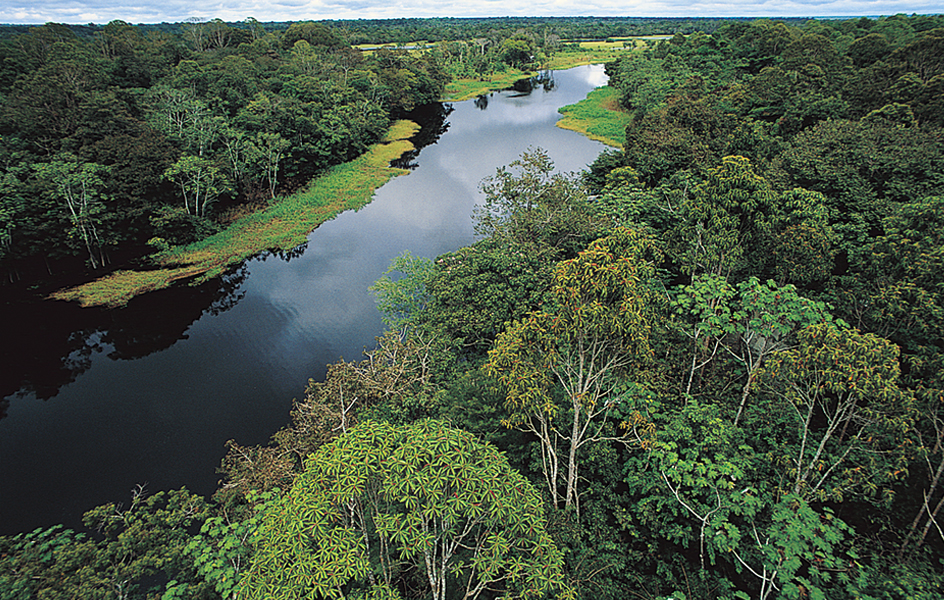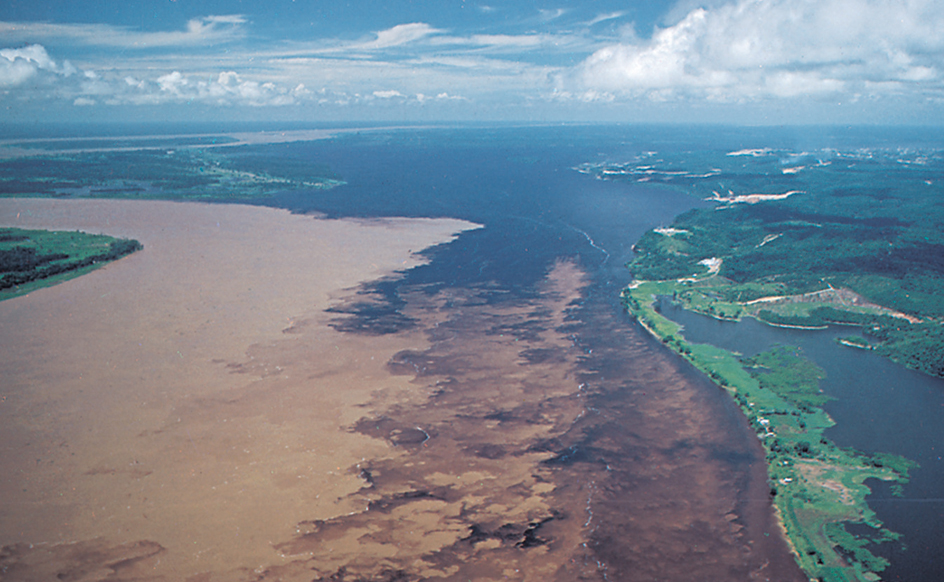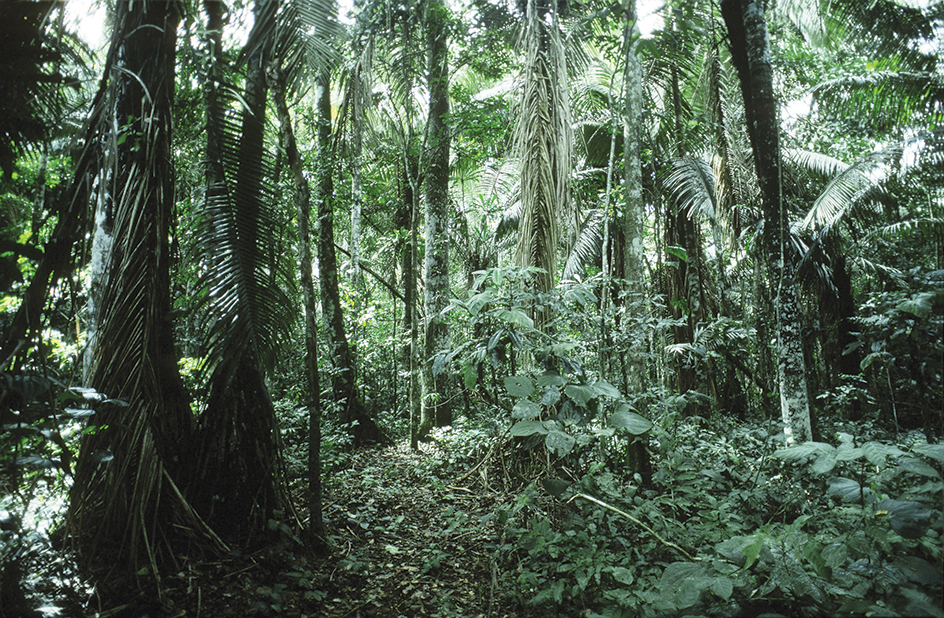Amazon << AM uh zahn >> River is the world’s second longest river and the chief river of South America. Only the Nile River in Africa is longer. The Amazon is 4,000 miles (6,437 kilometers) long. It carries more water than any other river and more than the Mississippi, Nile, and Yangtze rivers together. Each year, the Amazon delivers 15 percent of the fresh water that enters the ocean.

The Amazon is too wide at many points for a person on one bank to see the opposite shore. The river ranges from 11/2 to 6 miles (2.4 to 10 kilometers) wide for most of its course. It widens to about 90 miles (140 kilometers) at its mouth. The Amazon’s depth averages about 40 feet (12 meters) and increases to more than 300 feet (90 meters) in some places. The Amazon has a vast flood plain that covers 38,200 square miles (98,938 square kilometers) and is under water for up to half the year. Water levels fluctuate from 13 to 43 feet (4 to 13 meters) between low and high water.

The Amazon River Basin covers about 2,700,000 square miles (7,000,000 square kilometers) and includes the world’s largest tropical rain forest. The temperature averages about 80 °F (27 °C) and varies little throughout the year. Rainfall in the Amazon region ranges from 60 inches (152 centimeters) in low-lying areas to 175 inches (445 centimeters) near the Andes Mountains in Peru.
Most ships enter the Amazon River via the Pará River, south of Marajó Island. Ocean vessels can sail about 2,300 miles (3,700 kilometers) up the Amazon to Iquitos, Peru. Belém, on the Pará River about 90 miles (140 kilometers) from the Atlantic coast, and Manaus, 1,000 miles (1,600 kilometers) upstream from the mouth of the Amazon, are important ports. Ships bring in clothing, food, equipment, machinery, oil, and other products. They pick up such raw materials as Brazil nuts, cattle, soybeans, and other agricultural products; lumber; and rubber. They also take aboard live birds, fish, and other animals for pet shops and zoos.
The course of the Amazon
begins high in the Andes of Peru as a small stream that flows into the Apurímac River. The Apurímac is 17,200 feet (5,240 meters) above sea level. It flows northwest into the Ucayali River, the southern branch of the Amazon in Peru. The Ucayali flows north, down through the Andean foothills, then turns east and joins the Marañón River, the Amazon’s northern branch. This junction occurs near Iquitos and forms the main channel of the Amazon. The river continues eastward across Brazil and flows into the Atlantic Ocean north of Marajó Island.
The rivers that form the Amazon tumble rapidly through the Andes and fall about 16,400 feet (5,000 meters) in the first 600 miles (970 kilometers). The Amazon itself falls about 340 feet (100 meters) between Iquitos and the Atlantic Ocean, which lies about 2,300 miles (3,700 kilometers) east. The river flows at about 11/2 miles (2.4 kilometers) per hour during the dry season. Its flow increases to about 3 miles (5 kilometers) per hour when it is swollen by rain, during the annual flood.
More than 1,000 tributaries flow into the Amazon. They include the Japurá, Juruá, Madeira, Purus, Tapajós, Xingu, and Rio Negro rivers. Few of the tributaries have dams that help generate electricity, and no dam or bridge spans the Amazon.

An unusually high ocean tide occasionally overpowers the current at the mouth of the Amazon. This creates a wall of water called a bore that typically measures up to 6.5 feet (2 meters) high and rushes upstream.
Animal and plant life.
Many kinds of fish live in the Amazon River and the lakes on its flood plain. They include the fierce, flesh-eating piranha and the arapaima, one of South America’s largest freshwater fish. Many aquarium fish sold in pet shops come from the Amazon. Some species of river catfish migrate from near the mouth of the Amazon upstream to the Andes foothills to spawn. They swim a distance of 2,500 to 3,100 miles (4,000 to 5,000 kilometers). The river basin is home to such animals as anacondas, caimans, monkeys, parrots, sloths, and many species of insects.
The Amazon rain forest has a great variety of plant life. Scientists have found more than 40,000 plant species in the Amazon River Basin. The trees may reach heights of more than 130 feet (40 meters). Their tops grow so close together that only a little sunlight reaches the ground.

History.
Indigenous (native) people lived in the Amazon River Basin before white people came to the area. Vicente Yañez Pinzón, a Spanish explorer, was probably the first European to see the Amazon. In 1500, he sailed to the coast of what is now Brazil. During 1541 and 1542, the Spaniard Francisco de Orellana led the first European exploration of the river. His expedition followed the Amazon from the mouth of the Napo River in Peru to the Atlantic. During Orellana’s journey, what appeared to be Indigenous women warriors attacked his crew. The Spaniards called their attackers Amazons, after women warriors in Greek mythology. The name later was given to the river and the nearby area.
In the mid-1800’s, trees in the Amazon River Basin became an important source of wild rubber. But after about 1910, plantations in southern Asia began producing rubber more cheaply. The demand for Amazon rubber fell, and the regional economy collapsed. Since the 1960’s, Brazil’s government has built more and more highways and airports in the Amazon River Basin. New towns and farms have been established in this region, and its population has grown. Today, more than half of the Amazon’s people live in towns and cities.
Increasing demands for natural resources threaten the Amazon rain forest. Forest fires, mining, and the clearing of land for agriculture and industry have caused rapid destruction of the local plant and animal life.
